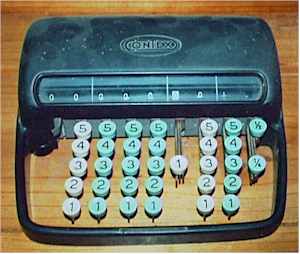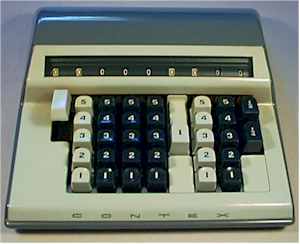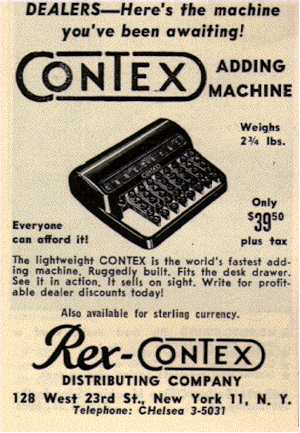| Contex |
 |
 |
| "The first attachment
is a photo of a sterling-currency version of this model. The actual machine is in a museum
display, so I was unable to investigate it closely. The second attachment is a photo of a functionally identical Contex from my collection, in what looks like 1960s styling. The serial number is 911428. Michel Bardel's list dates Contex production to 1960, so this was presumably a fairly late model. It still has the price ticket underneath - it cost 24 pounds 15 shillings, roughly equivalent to 50 US dollars. The Contex mechanism is very simple, with many parts constructed from red fibreboard. It's operation is unusual in that all the keys in a row move together - pressing (say) the 4 key picks up the 3,2,and 1, and then the whole lot move down together to the bottom of the stroke. The stroke of the topmost keys is a full inch, which must have been very awkward for the operator, and there is no protection against partial depression (as in the Comptometer). I have partially disassembled this latter machine, and taken a number of photographs of the mechanism. I hope to annotate these and make them available shortly." John Wolff. Source: John Wolff - Melbourne, Australia - July 6, 1999 |
 |
| "I looked at the bottom of my Contex and it has three US patents: 2472519, 2499946 and 2503613. The sales of Contex in Sweden began 1946 and that may be the correct introduction year because Denmark and Sweden are near neighbours." Timo |
Source: Timo Leipala (THE OFFICE - January, 1950)
|
|
Recently I have been able to spend a little
time re-organising the Contex machines in the collection and searching
the web for supporting information. Data from your site has been
helpful, as has information from Leif Kristensen. Although I
did not set out to amass Contex machines I do seem to have quite a lot,
some thirty in all! From these I have been able to deduce
some perhaps useful information.
I have eight of the so-called "A"
models and can identify four different machines in this group. The
brown bakelite models include decimal keyboards, and sterling keyboards
with and without farthings. There is also a white plastic
(bakelite?) model with a sterling keyboard. All of these have
apparently sequential serial numbers, the earliest being 73,053 and the
last (white machine) 124,773.
I also have eight of the "B"
models and can identify three different machines, being decimal
keyboard, and sterling with and without farthings. The serial
numbers for the sterling machines seem to follow on from those of the
model "A", from133,605 to 605,885. With the decimal
keyboards, all bear serial numbers of nine digits starting with
"411", and I deduce this to be a model number, supported by
evidence in the next paragraph.
The remaining machines are the
adding/calculating models with the 0-9 keypad.
There appear to be two different machines
within the "Contex 10" label. One type has a dark
grey plastic body and the serial number again of nine digits but
starting with "431". The second type is of a lighter
grey, has a slightly different register presentation and the serial
number commencing with "434". A former serviceman
on the Contex machines confirms the existence of an upgraded model 10,
identifiable by the plastic colour.
The "Contex 20" models I have feature
the dark grey plastic case, and serial numbers beginning with
"453" . The same serviceman said that there was an
upgraded model with the lighter grey case but I have not been able to
locate one of these.
The "Contex 30" models have
the serial numbers beginning with "473", and the "Contex
55" models with "493".
|